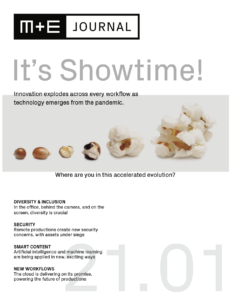
2021 Edition of MESA’s Spring/Summer M&E Journal Goes Live
The spring/summer edition of the “M&E Journal,” published by MESA and geared toward senior media and entertainment executives who oversee their companies’ digital futures, is now available online.
The 170-page publication features insights from nearly four dozen MESA members, from ATMECS to Xcapism Learning, with the issue’s main focus centered on how productions have evolved due to the challenges presented by the pandemic.
Along with the cover section — “It’s Showtime!” — the issue offers industry insights for several crucial industry areas, including “Diversity & Inclusion,” “New Workflows,” “Smart Content” and “Security.” Additionally, the “M&E Journal” also features columns from MESA’s executive leadership.
Here’s a quick look at what’s included in the “New Workflows” section:
• “From Experiments to Dependability,” by EditShare’s Stephen Tallamy. In 2020, the industry coped with massive, enforced change, but was successful in embracing new technology by shifting to cloud and virtualized environments, changing the dynamics of TV content production. The most recent cloud and virtualized environments can enhance productivity for content makers and feed the ever-increasing demands from streaming and OTT services.
• “Securely Preserving Digital Content in a Hybrid Storage Architecture,” by Digital Bedrock’s Linda Tadic and Wasabi’s Whit Jackson. Media workflows have gone through tremendous transformation with traditional infrastructure and processes giving way to virtualized operations using cloud compute and storage. Valuable media assets, however, still need to be secured for long-term preservation. With thoughtful planning, hybrid storage architectures can be deployed so both active access and managed preservation can be achieved.
• “Establishing a Remote Editorial Pipeline in the Cloud,” by Matt Herson and Brandon Lindauer, Amazon Web Services. In the world of working remote and limited personal onset the entire production ecosystems has been forced to evolve. Capturing data from the camera, or DIT station and sending it to a globally accessible location has moved from an Idea to a reality. Unlocked an editor’s ability to work from anywhere and still have a pleasant experience. This new age of cloud-based editorial is alive and already possible AWS.
 • “SaaS is Changing the Customer-Vendor Relationship,” by Signiant’s Brian Chavez. The advent of cloud technology has greatly expanded the conversation around what media companies expect from their technology stack, and is changing the ways buyers and sellers interact. Specifically, with SaaS solutions, the relationship between the vendor and the customer is at the heart of the buying process, and continues throughout the entire customer lifecycle.
• “SaaS is Changing the Customer-Vendor Relationship,” by Signiant’s Brian Chavez. The advent of cloud technology has greatly expanded the conversation around what media companies expect from their technology stack, and is changing the ways buyers and sellers interact. Specifically, with SaaS solutions, the relationship between the vendor and the customer is at the heart of the buying process, and continues throughout the entire customer lifecycle.
• “The Rise of Virtual Events,” by CineSend’s Eric Rosset. With the cancellation of in-person conferences, festivals and other media professional gatherings, 2020 saw the emergence of virtual events in the film and TV industry. NAB offered its first all-digital conference, Sundance pivoted to host an online streaming film festival edition, HBO launched a series on Zoom and CineSend, and in March the London Screenings largely took place online. In the future, we’re predicting hybrid events — a combination of in- person and online — to emerge. R&D will be invested to make virtual events more suitable to drive business and sales outcomes, with enhanced interactivity and relationship-building opportunities.
• “Navigating the Media and Entertainment Cloud Ecosystem in 2021 and Beyond,” by Joaquin Lippincott and Tony Rost, Metal Toad. The rapid evolution of media and entertainment technologies and the explosion of the public cloud have created both opportunities and a confusing landscape of legacy and new tech. On top of that, the coronavirus pandemic has increased the pressure to build best-in-class, simplified media workloads. Below is an overview of the three media workloads you need to optimize now: content creation, media supply chain, and content distribution.
• “How the Cloud is Fueling Virtualized Productions,” by PacketFabric’s Lisa Gerber. It’s well established that content production is moving to the cloud and content distribution is already fully there. Here we discuss how to approach the specific networking needs of virtual production, studio IP, and challenges and opportunities of using multiple cloud networking architectures. Further, we’ll explore best practices for employee empowerment, education, equal pay and honoring our own origin as a female-founded company.
• “The Age of Fully Virtualized Productions,” by Teradici’s Kevin Ottomeyer. Understanding M&E organizations and their requirements has been key to creating that ecosystem of solutions that enabled each unique studio to be successful on their journey to virtualization, either from an on-premises private cloud, a hybrid environment, or public cloud.
• “Taking the Digital Supply Chain Back In-House,” by OWNZONES’ Bill Admans. OWNZONES worked with a high-profile U.S. studio to take its supply chain in-house. Previous to this, the studio’s supply chain was outsourced to two service providers, one managing content, the other distribution. The desire to move operations to the cloud under Amazon Web Services also allowed the studio to consolidate its supply chain, gain greater control and ownership while maintaining cost-effectiveness.
• “New Consumer Expectations Can Lead to Post-Production Complexities,” by Vubiquity’s Darby Walker. While OTT cost is still a factor with consumers, it’s no longer the most significant reason they stick around. When asked what drives their loyalty, our research found almost half of consumers said the amount of content, followed by the quality of content (43 percent) and pricing (24 percent). When asked why consumers canceled a service, lack of exciting content was the main reason (38 percent). With roughly the top eight global content producers slated to spend more than $100 billion on content creation, an accelerated production path to revenue conversion will remain in focus. Here’s what content providers can do to keep up with demand.
• “Securing Localization in the Cloud,” by OOONA’s David Kirk. Main aspects of any cloud project need to include a highly scalable, secure infrastructure, being sure it can handle wide fluctuations in customer traffic, and that it can establish a fully automated release cycle.
Beginning Monday, June 7, look for stories from the winter edition of the “M&E Journal” every week in the “M&E Daily” newsletter.
